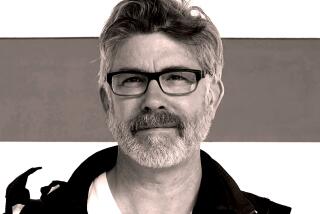Sex’s best-kept secret
- Share via
CHICAGO — Tupperware may prove instructive here.
When you think of how sex and the Midwest are juxtaposed in the public imagination, think of a Tupperware container. To seal the lid, you must run a couple of fingers along the edge, allowing the air inside to exit incrementally. If you just jam the heel of your hand down on one side, the other side will pop up. When you attempt to subdue the second half, the first will break free.
That is how popular culture has often portrayed Midwestern sexuality -- as something so repressed and shut down that it couldn’t help but find another outlet through which to escape.
That, of course, is hogwash, but the impression still lingers among some outsiders that “Midwestern sexuality” is a sniggering oxymoron.
From early in the last century to the recent past, novels, plays and songs have described a Heartland so deeply mired in denial about the varieties and bounteousness of human sexuality that folks try to keep it under wraps. And because they do that, and do it rather clumsily, they end up forcing all kinds of even less savory behavior -- murder, rape, all-night dancing or original thinking -- to the fore.
Behold films such as “Footloose” (1984) or -- stained by a much darker hue -- “Badlands” (1973); novels such as Sherwood Anderson’s “Winesburg, Ohio” (1919) or Sinclair Lewis’ “Main Street” (1920); plays such as William Inge’s “Picnic” (1948) or Tennessee Williams’ “The Glass Menagerie” (1945); music such as Bruce Springsteen’s “Nebraska” (1982) or John Mellencamp’s “American Fool” (1982), which includes the telltale “Jack and Diane”; or radio shows such as Garrison Keillor’s “Prairie Home Companion.”
As Springsteen, channeling a Midwestern serial killer, sings in the “Nebraska” title track: “I can’t say that I’m sorry for the things that we done / At least for a little while, sir, me and her we had us some fun.”
The prevailing theory behind these works: By denying sexual impulses, the Midwest unleashes even wilder stuff -- the other side of the Tupperware container inevitably pops up -- because human nature will not be restrained. Refused the easy way out, it will build up and rush to the next available exit, and that one might be a doozy.
Narrow notions
These ideas are predicated on the notion that the Midwest -- that flat beige swath of the country that lies roughly halfway between the wild stripe called the West Coast and the glittering strip known as the East Coast -- is grimly conventional; that is, it stubbornly values tradition and stability above all else, eschews newfangled fashions and fresh ideas, is suspicious of innovation and is stuck in the mud.
Ernest Hemingway, who hailed from the Chicago suburb of Oak Park, is supposed to have complained about the “broad lawns and narrow minds” of his hometown. Hemingway scholars can’t verify that he ever actually said it, but the quote sticks to him nonetheless, perhaps because it accurately reflects a certain relief implied by those tough, manly tales of his, those yarns set in exotic lands that use a variety of pinched-off words to suggest one theme: Thank God I got the heck out of Oak Park.
In the Midwest, sex, according to the traditional stereotype, is frowned upon and whispered about, and acknowledged only when absolutely necessary -- when, for instance, a woman begins showing undeniable signs of pregnancy, whereupon it may be generally (if reluctantly) acknowledged that yes, she apparently did engage in sexual relations with her husband, but surely only once. (And surely neither really enjoyed it.)
There’s just one small hitch in this nice little portrait: the 20th century.
Hustling into a new era
In the modern era, the Midwest has supplied much of the solid underpinning for the sexual revolution. Alfred Kinsey did his work at Indiana University, not UC Santa Cruz. The most extensive report on sexual habits since Kinsey, the Chicago Health and Social Life Survey, comes from hardy Midwestern folks at the University of Chicago, not racy Bostonians at Harvard.
William H. Masters and Virginia E. Johnson carried out their two landmark studies of the physiology of human sex in St. Louis, not New Orleans. When Hugh Hefner launched Playboy, the magazine devoted to chronicling the earth-moving change in sexual mores, he did it in Chicago, not New York or Miami Beach. Larry Flynt’s Hustler magazine? Published in, of all places, Ohio.
This has always struck me as so exceedingly ironic as to be definitely intentional. That is, whatever brooding intelligence designed and watches over us must possess, in addition to eternal dominion over earth and sky, a rather naughty sense of humor.
First, you establish a region that everyone makes fun of for its stultifying backwardness, its blundering lack of style. Then you allow the denizens of that region to create the ideas and celebrate the lifestyles that will upend the world’s assumptions about sexuality.
You lull the world into a comfortable set of false assumptions about the Midwest -- about its diffidence in matters of the flesh, its general distaste for clenched bodies and lubricious desires -- and then you lower the boom: The Midwest is a sexy place. Beneath those plaid flannel shirts beat hearts of pure, inexorable passion.
Just when you think you’ve got the Midwest’s number, it comes up with a James Dean -- the actor born and raised in Indiana who set the 1950s aflame with his candidly emotional style, his fluid, androgynous sexuality. “You’re tearing me apart!” is his signature cry, uttered in “Rebel Without a Cause” (1955), a film that illustrates -- albeit awkwardly and melodramatically -- the crazy engine of teenage desire. Thwarted by adults, that desire revs and revs until it seems powerful enough to light the world -- and sometimes it surely does.
Stealth sexuality
The Midwest’s simmering, underground sexuality is its great and wonderful secret. The region’s two best writers -- Willa Cather and F. Scott Fitzgerald -- knew that: Cather with her ambitious heroines who think they must flee small Midwestern towns to find fame and fulfillment, Fitzgerald with his suave heroes who go East because they think it’s required of bright young men. But the Midwestern ethos haunts them always, and their lives are a process of discovery of just how essential geography can be in shaping the soul.
Because the Midwest doesn’t wear its sexiness on its sleeve -- plaid or otherwise -- it fools you into thinking it can’t stoke such fierce desires in people. But it can and does, and Fitzgerald hints at that in a passage in “The Great Gatsby” (1925) about a train journey: “When we pulled out into the winter night and the real snow, our snow, began to stretch out beside us and twinkle against the windows, and the dim lights of small Wisconsin stations moved by, a sharp wild brace came suddenly into the air. We drew in deep breaths of it as we walked back from dinner through the cold vestibules, unutterably aware of our identity with this country for one strange hour, before we melted indistinguishably into it again.”
The Midwest likes to do that, likes to apply that “sharp wild brace” to our expectations. I suppose the lesson in all this is: Never think you know the last word about anything, the final truth about anyplace. A primitive insight, perhaps, and one that rings with a you-shoulda-learned-that-in-Sunday-school obviousness, yet it’s never too late to discover what’s been there all along: complication, nuance and surprise.
The world may see the Midwest as musty and sluggish and repressed, but that’s like looking at a winter landscape and assuming the field is dead forever. Nope: It’s just biding its time, lying low, doing precisely what it’s supposed to do -- and come spring, look out.
Julia Keller is cultural critic at the Chicago Tribune
More to Read
Sign up for our Book Club newsletter
Get the latest news, events and more from the Los Angeles Times Book Club, and help us get L.A. reading and talking.
You may occasionally receive promotional content from the Los Angeles Times.







